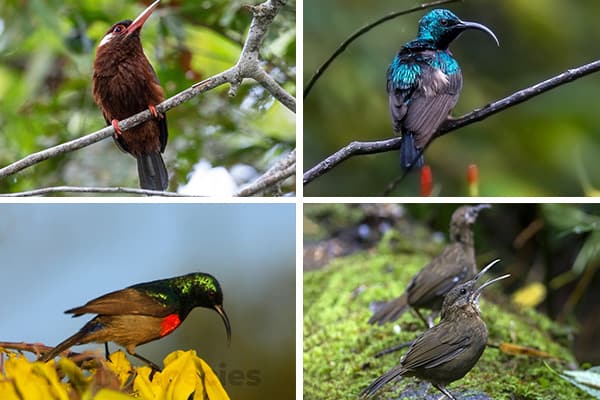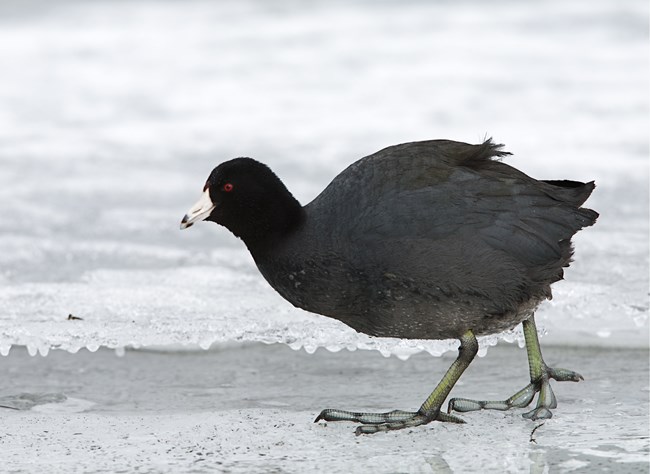11 Birds with Long Beaks (With Photos & Facts)
Birds with long beaks are truly fascinating. My research reveals how these beaks are tailored for specific feeding strategies. They excel at reaching nectar deep within flowers or probing the mud for insects. Each long beak type has unique adaptations for survival. Discover how these birds use their beaks to thrive in diverse environments. Let’s explore the incredible ways long beaks shape their lives!
1. Sword-billed Hummingbird
- Scientific name: Ensifera ensifera
- Size: 13-14 cm (5.1-5.5 inches)
- Weight: 10-15 g (0.35-0.53 oz)
- Lifespan: 5-10 years
- Diet: Nectar, small insects
The Sword-billed Hummingbird is nature’s living marvel, boasting a beak longer than its entire body! This extraordinary bird, found in the Andes Mountains of South America, is a true master of adaptation. Its incredibly long bill, measuring up to 10 cm (4 inches), is perfectly designed to reach deep into the long, tubular flowers that other hummingbirds simply can’t access.

Despite its imposing beak, the Sword-billed Hummingbird is a agile flyer, zipping from flower to flower with remarkable grace. Its unique anatomy allows it to feed on a variety of plant species, including the passion flower and angel’s trumpet, which have co-evolved with this remarkable bird. The Sword-billed Hummingbird’s specialized beak not only ensures its survival but also plays a crucial role in pollinating these hard-to-reach flowers, making it an essential part of its ecosystem.
2. Cerulean Kingfisher
- Scientific name: Alcedo coerulescens
- Size: 14-15 cm (5.5-5.9 inches)
- Weight: 20-30 g (0.7-1.1 oz)
- Lifespan: 6-10 years
- Diet: Small fish, aquatic insects, crustaceans
The Cerulean Kingfisher, with its dazzling blue plumage and long, pointed beak, is a jewel of Southeast Asian waterways. This small but striking bird is found near streams, rivers, and coastal areas in Indonesia, Malaysia, and the Philippines. Its birds with long beaks, while not as extreme as some others on this list, is perfectly adapted for its fishing lifestyle.
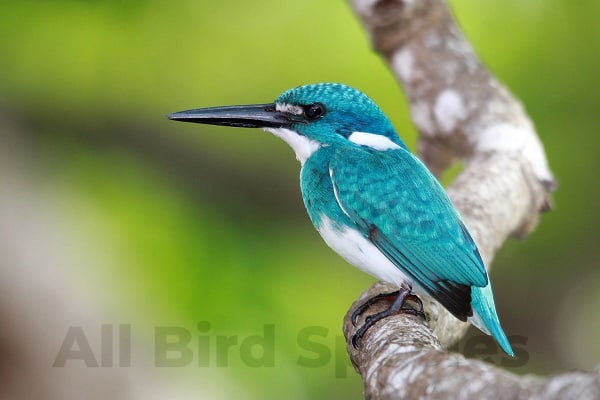
With lightning-fast reflexes, the Cerulean Kingfisher uses its beak like a precision spear to catch small fish and aquatic insects. It often perches on branches overhanging water, patiently waiting for the perfect moment to dive. The bird’s keen eyesight and specially adapted beak allow it to plunge into the water and snatch its prey with remarkable accuracy. This beautiful bird not only adds a splash of color to its habitat but also plays a vital role in controlling fish and insect populations in its ecosystem.
3. Slender-billed Scimitar Babbler
- Scientific name: Pomatorhinus superciliaris
- Size: 20-22 cm (7.9-8.7 inches)
- Weight: 30-40 g (1.1-1.4 oz)
- Lifespan: 8-12 years
- Diet: Insects, small invertebrates, berries
The Slender-billed Scimitar Babbler is a fascinating bird native to the Himalayan region and parts of Southeast Asia. Its most distinctive feature is its long, curved beak, reminiscent of a Turkish scimitar sword. This unique adaptation allows the bird to probe into crevices, under bark, and among leaf litter in search of its insect prey.
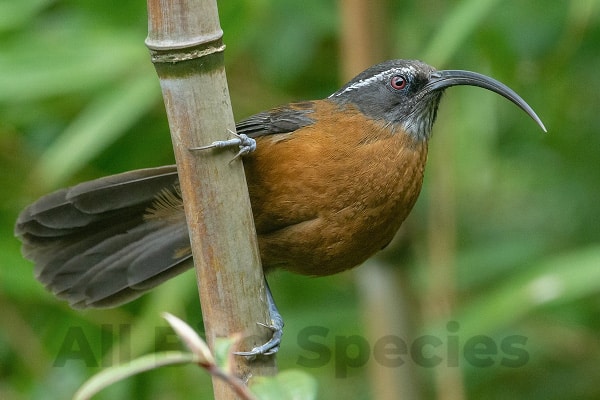
Despite its imposing beak, the Slender-billed Scimitar Babbler is a relatively shy and elusive bird. It prefers the dense undergrowth of subtropical and temperate forests, where its mottled brown plumage provides excellent camouflage. The bird’s long beak not only helps in foraging but also plays a role in its courtship displays and nest-building activities. Its haunting, melodious calls often reveal its presence long before it can be seen, adding a touch of mystery to its forest home.
4. Little Spiderhunter
- Scientific name: Arachnothera longirostra
- Size: 14-17 cm (5.5-6.7 inches)
- Weight: 8-12 g (0.28-0.42 oz)
- Lifespan: 5-8 years
- Diet: Nectar, small insects, spiders
The Little Spiderhunter, despite its name, is more of a nectar specialist than an arachnid hunter. This small bird, found in the tropical and subtropical forests of South and Southeast Asia, sports a remarkably long, curved beak that’s perfectly adapted for reaching deep into flowers. Its scientific name, ‘longirostra’, literally means ‘long-billed’ in Latin.

With its olive-green plumage and distinctive yellow eyebrow stripe, the Little Spiderhunter might not be the most colorful bird in the forest, but it’s certainly one of the most interesting. Its long beak allows it to access nectar from a wide variety of flowers, including banana blossoms and ginger plants. While feeding, it often hovers like a hummingbird, showcasing its agility. The Little Spiderhunter also plays a crucial role in pollination, helping to maintain the diversity of its forest ecosystem.
5. Eastern Spinebill
- Scientific name: Acanthorhynchus tenuirostris
- Size: 13-16 cm (5.1-6.3 inches)
- Weight: 9-11 g (0.32-0.39 oz)
- Lifespan: 5-10 years
- Diet: Nectar, small insects
The Eastern Spinebill birds with long beaks is a small honeyeater native to eastern Australia, easily recognized by its long, downward-curved bill and striking plumage. Its scientific name, ‘tenuirostris’, means ‘thin-billed’ in Latin, aptly describing its slender, needle-like beak. This specialized tool allows the Eastern Spinebill to probe deep into tubular flowers that other birds can’t access.
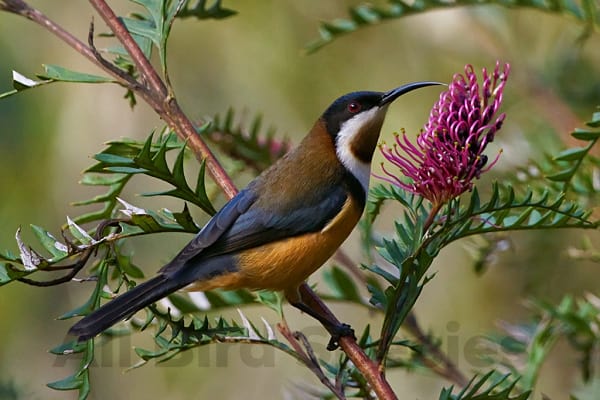
With its black, white, and chestnut coloration, the Eastern Spinebill is a beautiful sight as it flits from flower to flower in gardens and woodlands. Its long bill is not just for feeding; it also plays a role in the bird’s courtship displays. Males will often chase each other, showing off their agility and the length of their bills. The Eastern Spinebill’s feeding habits make it an important pollinator in its ecosystem, helping to maintain the health and diversity of native Australian plant species.
6. Mountain Velvetbreast
- Scientific name: Lafresnaya lafresnayi
- Size: 11-12 cm (4.3-4.7 inches)
- Weight: 5-6 g (0.18-0.21 oz)
- Lifespan: 4-8 years
- Diet: Nectar, small insects
The Mountain Velvetbreast is a stunning hummingbird species found in the Andes Mountains of South America. Its most notable feature is its long, slightly curved bill, perfectly adapted for feeding on the tubular flowers that grow at high altitudes. The bird’s name comes from the velvety appearance of its dark green plumage, which shimmers in the sunlight.
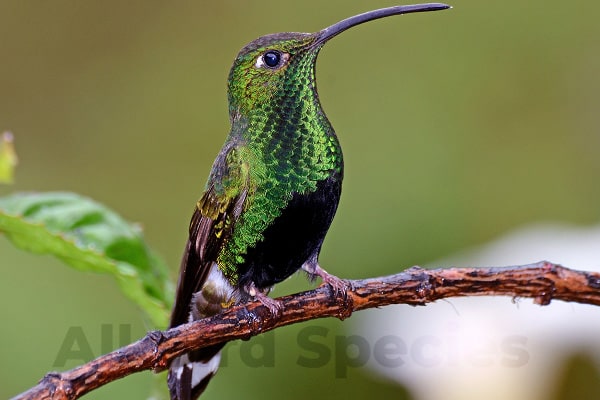
Despite its small size, the Mountain Velvetbreast is a hardy bird, capable of surviving in the challenging conditions of its high-altitude home. It’s often found hovering near flowering plants, using its long bill to extract nectar with precision. The Mountain Velvetbreast’s feeding habits make it an important pollinator in its mountain ecosystem, helping to maintain the diversity of high-altitude plant species. Its ability to thrive in such extreme environments is a testament to the remarkable adaptability of these long-beaked birds.
7. Greater Double-collared Sunbird
- Scientific name: Cinnyris Afer
- Size: 12-14 cm (4.7-5.5 inches)
- Weight: 7-11 g (0.25-0.39 oz)
- Lifespan: 5-8 years
- Diet: Nectar, small insects
The Greater Double-collared Sunbird is a dazzling bird native to southern Africa, known for its iridescent plumage and long, curved bill. The male of the species is particularly striking, with a metallic green head, a blue-purple throat, and two distinctive collars – one blue and one red – which give the bird its name. Its long bill is perfectly adapted for reaching the nectar at the base of tubular flowers.
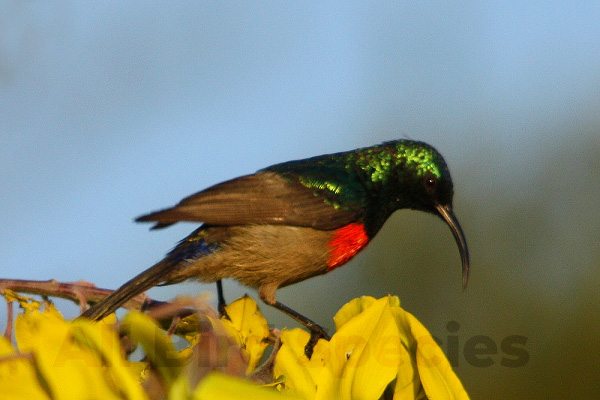
This birds with long beaks is a common sight in gardens, forests, and fynbos regions of South Africa. It’s an agile flyer, often seen hovering like a hummingbird as it feeds. The Greater Double-collared Sunbird’s feeding habits make it an important pollinator in its ecosystem, particularly for native plant species with long, tubular flowers. Its beautiful appearance and cheerful chirping make it a favorite among birdwatchers and garden enthusiasts alike.
8. Short-tailed Scimitar Babbler
- Scientific name: Pomatorhinus bornensis
- Size: 18-20 cm (7.1-7.9 inches)
- Weight: 30-40 g (1.1-1.4 oz)
- Lifespan: 8-12 years
- Diet: Insects, small invertebrates, berries
The Short-tailed Scimitar Babbler, despite its name, boasts a notably long, curved bill that resembles a scimitar sword. This bird is native to the island of Borneo, where it inhabits lowland and hill forests. Its brown plumage provides excellent camouflage in its forested habitat, making it a master of stealth.
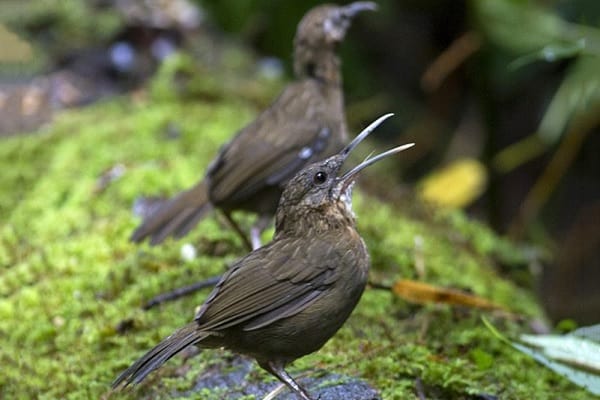
Using its specialized beak, the Short-tailed Scimitar Babbler probes into crevices, under bark, and among leaf litter in search of insects and other small invertebrates. This feeding behavior not only sustains the bird but also helps to control insect populations in its ecosystem. The bird’s long bill also comes in handy for nest building, allowing it to weave intricate nests hidden in dense vegetation. Though not as colorful as some other long-beaked birds, the Short-tailed Scimitar Babbler’s unique appearance and behavior make it a fascinating subject for ornithologists and bird enthusiasts.
9. Loten’s Sunbird
- Scientific name: Cinnyris lotenius
- Size: 11-12 cm (4.3-4.7 inches)
- Weight: 7-10 g (0.25-0.35 oz)
- Lifespan: 5-8 years
- Diet: Nectar, small insects
Loten’s Sunbird birds with long beaks, also known as the Long-billed Sunbird, is a small but vibrant bird found in parts of South Asia, particularly in India and Sri Lanka. Its most distinctive feature is its exceptionally long, curved bill, which is perfectly adapted for feeding on nectar from a variety of flowers. The male of the species is particularly striking, with iridescent blue-green plumage and a maroon breast band.

This agile little bird is often seen flitting from flower to flower in gardens, woodlands, and forest edges. Its long bill allows it to access nectar from flowers that other birds can’t reach, making it an important pollinator in its ecosystem. Loten’s Sunbird is known for its beautiful, melodious song, which the male often sings from a prominent perch to defend its territory and attract mates. Despite its small size, this sunbird plays a big role in maintaining the biodiversity of its habitat.
10. White-eared Jacamar
- Scientific name: Galbalcyrhynchus leucotis
Size: 18-20 cm (7.1-7.9 inches)
Weight: 25-35 g (0.88-1.23 oz)
Lifespan: 7-10 years
Diet: Flying insects, especially butterflies and moths
The White-eared Jacamar Birds with Long Beaks is a striking bird found in the Amazon Basin of South America. Its most notable feature is its long, straight bill, which it uses with remarkable precision to catch flying insects. The bird’s name comes from the distinctive white patches on either side of its head, contrasting beautifully with its overall dark plumage that shimmers with green and blue iridescence in the sunlight.

This jacamar is often seen perched on exposed branches near rivers or in forest clearings, patiently waiting for insects to fly by. When it spots its prey, it launches into a swift, acrobatic flight, using its long bill like a pair of tweezers to snatch insects mid-air. The White-eared Jacamar’s feeding habits help to control insect populations in its ecosystem, playing a crucial role in maintaining the ecological balance of its Amazonian home.
11. Violet Sabrewing
- Scientific name: Campylopterus hemileucurus
- Size: 15-17 cm (5.9-6.7 inches)
- Weight: 11-12 g (0.39-0.42 oz)
- Lifespan: 5-10 years
- Diet: Nectar, small insects
The Violet Sabrewing is one of the largest hummingbird species, found in the cloud forests of Central America and parts of Mexico. Its most striking features are its brilliant violet plumage and its long, slightly curved bill, which is perfectly adapted for feeding on long, tubular flowers. The male of the species is particularly spectacular, with its iridescent violet body and forked tail.
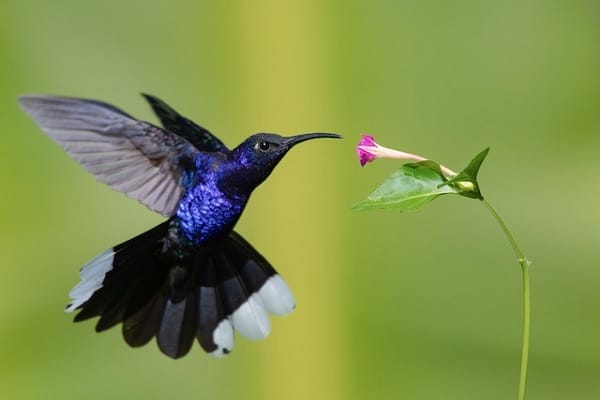
This impressive hummingbird is often seen hovering near flowering trees and shrubs in montane forests and coffee plantations. Its large size and long bill allow it to dominate feeding territories, often chasing away smaller hummingbird species. The Violet Sabrewing plays a crucial role in its ecosystem as a pollinator, particularly for plants with long, curved flowers that have co-evolved with these specialized birds. Its beauty and unique characteristics make it a favorite among birdwatchers and nature enthusiasts.
Read More🐦Related Articles:
- Bird Beak Types
- Hawks in Mississippi
- Birds of Prey in Pennsylvania
- Eagles in Russia
- Red-Tailed Hawk: A Majestic Raptor
Final Thoughts
In conclusion, these 16 bird species with their remarkably long beaks showcase the incredible diversity and adaptability of avian life. From the sword-wielding hummingbird to the nectar-sipping sunbirds and the insect-hunting jacamars, each of these birds has evolved its specialized bill to fill a unique ecological niche. These long beaks serve as multipurpose tools, allowing the birds to access food sources that would otherwise be out of reach, build intricate nests, and even play a role in courtship displays.

